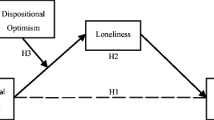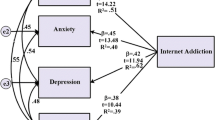Abstract
The aim of the present study was to examine the addictive effects of personal susceptibility and social support from family, friends, and significant other on Internet addiction. In this study, 207 medical students completed the UCLA Loneliness Scale, the Academic Expectations Stress Inventory, the Multidimensional Scale of Perceived Social Support, and the Young’s Diagnostic Questionnaire for Internet addiction. Participants were recruited via simple random sampling technique. Personal susceptibility variables such as loneliness, academic stress due to other expectations, and academic stress due to self-expectations were significantly positively correlated to, and all domains of social support were significantly negatively correlated to, Internet addiction. After adjusting for demographic variables, social support emerged as a significant predictor of Internet addiction in the hierarchical regression analysis. In support of Adler’s individual psychology theory, the present findings suggest that social support from family is a valuable adjunct to prevention and intervention programs aimed at alleviating Internet addiction in medical students.
Similar content being viewed by others
References
American Psychiatric Association. (2013). Diagnostic and statistical manual of mental disorders (5th ed.). Washington, DC: Author.
Anderson, K. J. (2001). Internet use among college students: an exploratory study. Journal of American College Health, 50(1), 21–26.
Ang, R. P., & Huan, V. S. (2006). Academic expectations stress inventory development, factor analysis, reliability, and validity. Educational and Psychological Measurement, 66(3), 522–539.
Ang, R. P., Klassen, R. M., Chong, W. H., Huan, V. S., Wong, Y. F., Yeo, L. S., & Krawchuk, L. L. (2009). Cross-cultural invariance of the Academic Expectations Stress Inventory: adolescents samples from Canada and Singapore. Journal of Adolescence, 32, 1225–1237.
Ang, C. S., Talib, M. A., Tan, K. A., Tan, J. P., & Yaacob, S. N. (2015). Understanding computer-mediated communication attributes and life satisfaction from the perspectives of uses and gratifications and self-determination. Computers in Human Behavior, 49, 20–29.
Bishop, S. R., Lau, M., Shapiro, S., Carlson, L., Anderson, N. D., Carmody, J., & Devins, G. (2004). Mindfulness: a proposed operational definition. Clinical Psychology: Science and Practice, 11(3), 230–241.
Bjorksten, O., Sutherland, S., Miller, C., & Stewart, T. (1983). Identification of medical student problems and comparison with those of other students. Journal of Medical Education, 58, 759–767.
Bloom, Z. D., & Taylor, D. D. (2015). New problems in today’s technological era: an Adlerian case example. Journal of Individual Psychology, 71, 163–173.
Bozoglan, B., Demirer, V., & Sahin, I. (2013). Loneliness, self-esteem, and life satisfaction as predictors of Internet addiction: a cross-sectional study among Turkish university students. Scandinavian Journal of Psychology, 54, 313–319.
Brenner, M. H., Curbow, B., & Legro, M. W. (1995). The proximal-distal continuum of multiple health outcome measures: the case of cataract surgery. Medical Care, 33(4), 236–244.
Byun, S., Ruffini, C., Mills, J. E., Douglas, A. C., Niang, M., Stepchenkova, S., & Blanton, M. (2009). Internet addiction: metasynthesis of 1996–2006 quantitative research. CyberPsychology and Behavior, 12(2), 203–207.
Caplan, S. E. (2002). Problematic Internet use and psychosocial well-being: development of a theory-based cognitive-behavioral measurement instrument. Computers in Human Behavior, 18(5), 553–575.
Cheng, C., & Li, A. Y. (2014). Internet addiction prevalence and quality of (real) life: a meta-analysis of 31 nations across seven world regions. Cyberpsychology, Behavior, and Social Networking, 17(12), 755–760.
Cohen, J. (1988). Statistical power analysis for the behavioral sciences (2nd ed.). Hillsdale: Erlbaum.
Cohen, S., & Syme, S. L. (1985). Issues in the study and application of social support. Social Support and Health, 3, 3–22.
Cohen, J., Cohen, P., West, S. G., & Aiken, L. S. (2003). Applied multiple regression/correlation analysis for the behavioral sciences (3rd ed.). Mahwah: Lawrence Erlbaum.
Edwards, M. T., & Zimet, C. N. (1976). Problems and concerns among medical students—1975. Journal of Medical Education, 51, 619–625.
Ellis, P. D. (2009). Effect size calculators. Retrieved from http://myweb.polyu.edu.hk/~mspaul/calculator/calculator.html
Erdfelder, E., Faul, F., & Buchner, A. (1996). GPOWER: a general power analysis program. Behavior Research Methods, Instruments, and Computers, 28(1), 1–11.
Eroglu, M., Pamuk, M., & Pamuk, K. (2013). Investigation of problematic Internet usage of university students with psychosocial levels at different levels. Procedia-Social and Behavioral Sciences, 103, 551–557.
Forbes, A. (1996). Loneliness. British Medical Journal, 313, 352–354.
Frangos, C., Frangos, C., & Kiohos, A. (2010). Internet addiction among Greek university students: demographic associations with the phenomenon, using the Greek version of Young’s Internet addiction. International Journal of Economic Sciences and Applied Research, 1, 49–74.
Friedlander, L. J., Reid, G. J., Shupak, N., & Cribbie, R. (2007). Social support, self-esteem, and stress as predictors of adjustment to university among first-year undergraduates. Journal of College Student Development, 48(3), 259–274.
Halvorson, H. (2010). The cure for loneliness. The Science of Success. Retrieved July 14, 2014, from http://www.psychologytoday.com/blog/the-science-success/201010/the-cure-loneliness.
Huang, X., Zhang, H., Li, M., Wang, J., Zhang, Y., & Tao, R. (2010). Mental health, personality, and parental rearing styles of adolescents with Internet addiction disorder. CyberPsychology Behavior and Social Networking, 13(4), 401–406.
Jessor, R., Turbin, M. S., Costa, F. M., Dong, Q., Zhang, H., & Wang, C. (2003). Adolescent problem behavior in China and the United States: a cross-national study of psychosocial protective factors. Journal of Research on Adolescence, 13(3), 329–360.
Jin, B. (2013). How lonely people use and perceive Facebook. Computers in Human Behavior, 29, 2463–2470.
Johansson, A., & Götestam, K. G. (2004). Internet addiction: characteristics of a questionnaire and prevalence in Norwegian youth (12–18 years). Scandinavian Journal of Psychology, 45, 223–229.
Kaltiala-Heino, R., Lintonen, T., & Rimpela, A. (2004). Internet addiction? Potentially problematic use of the Internet in a population of 12–18 year-old adolescents. Addiction Research and Theory, 12, 89–96.
Kline, R. B. (2010). Principles and practice of structural equation modeling (3rd ed.). New York: Guilford Press.
Ling, C. S., Ramadass, S., Altaher, A. & Arjuman, N.C. (2011). Malaysian Internet Surfing Addiction (MISA): factors affecting the internet use and its consequences. In Computer Applications and Industrial Electronics (ICCAIE), 2011 I.E. International Conference on (pp. 585–590). IEEE.
Livingstone, S., & Helsper, E. J. (2008). Parental mediation of children’s Internet use. Journal of Broadcasting and Electronic Media, 52(4), 581–599.
Lou, L. L. (2009). Loneliness, friendship, and self-esteem: first-year college students’ experience of using Facebook. Albany: UMI Dissertation Publishing.
Mansor, A. T., Ang, C. S., & Tan, K. A. (2014). Pangs of loneliness breed material lifestyle but don’t power up life satisfaction of young people: the moderating effect of gender. Social Indicators Research, 117(2), 353–365.
Nalwa, K., & Anand, A. P. (2003). Internet addiction in students: a cause of concern. CyberPsychology and Behavior, 6(6), 653–656.
Niemz, K., Griffiths, M., & Banyard, P. (2005). Prevalence of pathological Internet use among university students and correlations with self-esteem, the General Health Questionnaire (GHQ), and disinhibition. CyberPsychology and Behavior, 8(6), 562–570.
Odacı, H., & Kalkan, M. (2010). Problematic Internet use, loneliness and dating anxiety among young adult university students. Computers and Education, 55(3), 1091–1097.
Peluso, P. R., Peluso, J. P., White, J. F., & Kern, R. M. (2004). A comparison of attachment theory and individual psychology: a review of the literature. Journal of Counseling and Development, 82, 139–145.
Peytchev, A., & Hill, C. A. (2010). Experiments in mobile web survey design: similarities to other modes and unique considerations. Social Science Computer Review, 28, 319–335.
Russell, D. W. (1996). UCLA Loneliness Scale (version 3): reliability, validity, and factor structure. Journal of Personality Assessment, 66(1), 20–40.
Sachau, B. (2004). Individual psychology in the teaching of foreign language and literature: a new approach in foreign language pedagogy and an Adlerian interpretation of selected works by Theodor Storm (Unpublished doctoral dissertation). The Pennsylvania State University.
Sanders, M. R. (1999). Triple P—Positive Parenting Program: towards an empirically validated multilevel parenting and family support strategy for the prevention of behavior and emotional problems in children. Clinical Child and Family Psychology Review, 2, 71–90.
Shapira, N. A., Goldsmith, T. D., Keck Jr., P. E., Khosla, U. M., & McElroy, S. L. (2000). Psychiatric features of individuals with problematic Internet use. Journal of Affective Disorders, 57(1), 267–272.
Shaw, L. H., & Gant, L. M. (2002). In defense of the Internet: the relationship between Internet communication and depression, loneliness, self-esteem, and perceived social support. CyberPsychology and Behavior, 5(2), 157–171.
Sinha, R. (2007). The role of stress in addiction relapse. Current Psychiatry Reports, 9(5), 388–395.
Tan, J. B., & Yates, S. (2011). Academic expectations as sources of stress in Asian students. Social Psychology of Education, 14(3), 389–407.
Watkins Jr., C. E. (1984). The individual psychology of Alfred Adler: toward an Adlerian vocational theory. Journal of Vocational Behavior, 24, 28–47.
Whiteman, S. D., McHale, S. M., & Soli, A. (2011). Theoretical perspectives on sibling relationships. Journal of Family Theory and Review, 3(2), 124–139.
Widyanto, L., & Griffiths, M. (2006). ‘Internet addiction’: a critical review. International Journal of Mental Health and Addiction, 4(1), 31–51.
Widyanto, L., & McMurran, M. (2004). The psychometric properties of the internet addiction test. CyberPsychology and Behavior, 7(4), 443–450.
Wilkinson, L., & APA Task Force on Statistical Inference. (1999). Statistical methods in psychology journals. Guidelines and explanations. American Psychologist, 54, 594–604.
Witkiewitz, K., & Villarroel, N. A. (2009). Dynamic association between negative affect and alcohol lapses following alcohol treatment. Journal of Consulting and Clinical Psychology, 77(4), 633–644.
Yadav, P., Banwari, G., Parmar, C., & Maniar, R. (2013). Internet addiction and its correlates among high school students: a preliminary study from Ahmedabad, India. Asian Journal of Psychiatry, 6(6), 500–505.
Yang, F., Tan, K.-A., & Cheng, W. J. Y. (2014). The effects of connectedness on health-promoting and health-compromising behaviors in adolescents: evidence from a statewide survey. Journal of Primary Prevention, 35(1), 33–46.
Yeh, Y. C., Ko, H. C., Wu, J. Y. W., & Cheng, C. P. (2008). Gender differences in relationship of actual and virtual social support to Internet addiction mediated through depressive symptoms among college students in Taiwan. CyberPsychology and Behavior, 11(4), 485–487.
Young, K. S. (1996). Psychology of computer use: XL. Addictive use of the Internet: a case that breaks the stereotype. Psychological Reports, 79(3), 899–902.
Young, K. S. (1998). Internet addiction: the emergence of a new clinical disorder. CyberPsychology and Behavior, 1(3), 237–244.
Young, K. S. (2004). Internet addiction a new clinical phenomenon and its consequences. American Behavioral Scientist, 48(4), 402–415.
Zainudin, A., Din, M. M., & Othman, M. (2013). CIMP Internet Addiction Guideline. International Journal of Asian Social Science, 3(9), 1967–1972.
Zimet, G. D., Dahlem, N. W., Zimet, S. G., & Farley, G. K. (1988). The multidimensional scale of perceived social support. Journal of Personality Assessment, 52(1), 30–41.
Acknowledgements
The author is grateful to Mohd Saifullah Mohd Arif Kor, Nur Amalina Tukiman, and Nurul Amyrah Che Ahmad Kamily for their help with data collection; Nor Sheereen Zulkefly, Normala Ibrahim, Firdaus Mukhtar, and Sherina Mohd Sidik for their comments on an earlier draft of this article.
Funding
No funding was obtained for this study.
Author information
Authors and Affiliations
Corresponding author
Ethics declarations
All procedures performed in studies involving human participants were in accordance with the ethical standards of the institutional and/or national research committee and with the 1964 Helsinki declaration and its later amendments or comparable ethical standards.
Conflict of Interest
The author declares that there are no conflicts of interest.
Informed Consent
Informed consent was obtained from all individual participants included in the study.
Rights and permissions
About this article
Cite this article
Tan, KA. The Effects of Personal Susceptibility and Social Support on Internet Addiction: an Application of Adler’s Theory of Individual Psychology. Int J Ment Health Addiction 17, 806–816 (2019). https://doi.org/10.1007/s11469-018-9871-2
Published:
Issue Date:
DOI: https://doi.org/10.1007/s11469-018-9871-2




